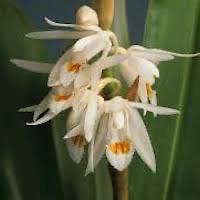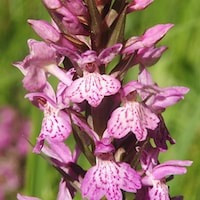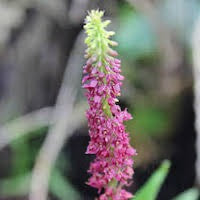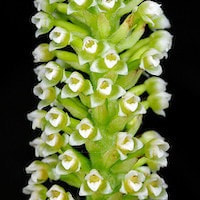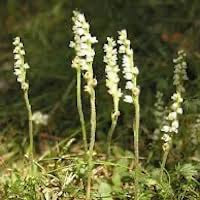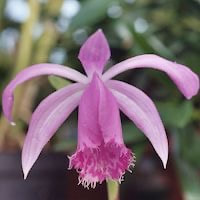WWD2- Women's Woody 2 - The temptress
|
Native Singaporean Orchid notes: Phalaenopsis Cornu-Cervi
Phalaenopsis Cornu-Cervi, featured in the Woody 2 (Women) perfume workshop for team building, is renowned for its fragrance and visual appeal. Selected by the Monetary Authority of Singapore for its $5 silver coin, this orchid's distinctive rachis supports 7 to 12 star-shaped flowers with lasting cinnamon-spicy scents. Its natural color variations range from dark cinnamon-red to yellow and pale green, enhancing its allure. The orchid's aromatic profile enriches the Woody 2 fragrance, making it a captivating choice for the workshop.
|
Therapeutic Orchid notes:
|
Coelogyne stricta (D. Don) Schltr. Syn Coelogyne elata Lindl.
Coelogyne stricta, known as Harjojan in India, is an orchid species valued for its medicinal properties and distinct scent. Phytochemical analysis has identified compounds like 9,10-dihydrophenanthropyrone and coelonin, which possess bacterostatic and fungistatic properties, inhibiting bacterial and fungal growth. In traditional medicine, it is used in northeast India for bone healing, applied externally on fractured limbs. In Nepal, poultices made from its pseudobulbs are applied to relieve headaches and fever, highlighting its therapeutic potential in diverse medical practices. |
|
Dactylorhiza salina (Turez exLindl.) Soo
Dactylorhiza salina, known as "Martsnii tsakhiram" in Mongolia and "Ban lag" in Tibetan, is an orchid species prized for its unique fragrance and medicinal properties. It thrives in damp, alkaline meadows across Mongolia's natural zones. In traditional herbal medicine, its root tubers, noted for a sweet and astringent taste, are used to treat edema, inflammation, and to boost overall vitality. This orchid is highly valued in Mongolia, where it is included in various traditional prescriptions, highlighting its esteemed role in local healing practices. |
|
Dienia ophrydis (J. Koenig) Seidenf. syn. Malaxis latifolia Sm., Anaphora lipaarioides Gagnep.
Dienia ophrydis, also known as Malaxis latifolia or Anaphora lipaarioides, is a terrestrial orchid species with various names in different languages, including Kuoyezhao Lan, Huazhu Lan, and others in Chinese, and Van dong and Van nam in Laotian. It blooms at different times across regions, flowering from May to June in Taiwan and from August to December in most continental areas like Assam, India. In Taiwan, it is valued for its medicinal properties, used as an herb with effects including fever reduction, diuresis, detoxification, anti-inflammatory properties, and swelling reduction. In Vientiane, Laos, its tubers are specifically applied as a paste to treat burns, highlighting its traditional medicinal significance in different cultures. |
|
Goodyera procera (Ker-Gawl.) Hook.
Goodyera procera, known by various names in Chinese and Taiwanese, is an orchid species with multiple traditional medicinal uses. It is called Tushagen, Gaobanyelan, and Zhengxijiao in Chinese, and Peng Sha Gen, Zheng Xi Jiao, and Sui Hua Ban Ye Lan in Taiwanese. Endangered in India but found in Nepal, Bhutan, China, and Hong Kong, it is valued for its therapeutic properties like dispelling wind, nourishing blood, and treating conditions such as rheumatism, asthma, and tuberculosis. Scientific research is needed to explore its chemical composition for potential new treatments, while conservation efforts are crucial due to its endangered status. |
|
Goodyera repens (L) R.Br.
Goodyera repens, known by various names globally, is a small terrestrial orchid with significant medicinal uses. In Chinese, it's called Nantoubanye Lan, Xiuzhenbanye Lan, and Xiaobanye Lan, and known as Dwarf rattlesnake plantain in North America and Creeping Ladies Tresses in Pakistan. It thrives in shady, moist soils across the northern hemisphere. Seeds germinate in spring after a dormant winter, taking up to 8 years to flower. Used in traditional medicine, it treats ailments like fever, tuberculosis, and snake bites, with further research needed on its chemical composition for potential new treatments. |
|
Pleione bulbocodioides (Franch.) Rolfe
Pleione bulbocodioides, known by various names across Asia, is a revered orchid species with significant medicinal properties. In China, Vietnam imports its pseudobulbs for treating food poisoning, intoxication, and insect bites. Traditionally used for boils, snake bites, and clearing phlegm, it's also employed against wet sores and sore throat. Rich in amentoflavone, it exhibits potent anti-inflammatory effects, inhibiting COX-2 expression and showing promise against influenza and herpes viruses. Other compounds like dusuanlansins also contribute to its therapeutic potential, suggesting broader applications pending further research. |
Other scent note
Scentopia Library Reference ingredient
Petitgrain - Check details at Scentopia's scent library
Download the guided mediation that works best with this Orchid fragrance oil
| women_woody_essential_oil_orchi_00002.mp3 | |
| File Size: | 115667 kb |
| File Type: | mp3 |

